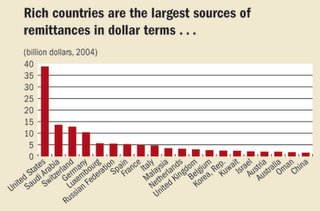….It was Spencer… who invented that poisoned phrase, “survival of the fittest�. ..originally applied it to the winnowing of firms in the harsh winds of high-Victorian capitalism, but when Darwin's masterwork, “On the Origin of Species�, was published, he quickly saw the parallel with natural selection and transferred his bon mot to the process of evolution…. became one of the band of philosophers known as social Darwinists. Capitalists all, they took what they thought were the lessons of Darwin's book and applied them to human society. Their hard-hearted conclusion …. was that people got what they deserved—albeit that the criterion of desert was genetic, rather than moral. The fittest not only survived, but prospered. Moreover, the social Darwinists thought that measures to help the poor were wasted, since such people were obviously unfit and thus doomed to sink.
... For 100 years Darwinism was associated with a particularly harsh and unpleasant view of the world and, worse, one that was clearly not true—at least, not the whole truth. People certainly compete, but they collaborate, too. They also have compassion for the fallen and frequently try to help them, rather than treading on them. For this sort of behaviour, “On the Origin of Species� had no explanation. As a result, Darwinism had to tiptoe round the issue of how human society and behaviour evolved….. the disciples of a second 19th-century creed, Marxism, dominated academic sociology departments with their cuddly collectivist ideas—even if the practical application of those ideas has been even more catastrophic than social Darwinism was.
…the real world …penetrates even the ivory tower. The failure of Marxism has prompted an opening of minds, and Darwinism is back with a vengeance—and a twist. Exactly how humanity became human is still a matter of debate. But there are, at least, some well-formed hypotheses... they rely not on Spencer's idea of individual competition, but on social interaction. That interaction is…sometimes confrontational and occasionally bloody. ..it is frequently collaborative, and even when it is not, it is more often manipulative than violent.
Modern Darwinism's big breakthrough was the identification of the central role of trust in human evolution. People who are related collaborate on the basis of nepotism. It takes outrageous profit or provocation for someone to do down a relative with whom they share a lot of genes. Trust….allows the unrelated to collaborate, by keeping score of who does what when, and punishing cheats.
Very few animals can manage this. .. outside the primates, only vampire bats have been shown to trust non-relatives routinely. (Well-fed bats will give some of the blood they have swallowed to hungry neighbours, but expect the favour to be returned when they are hungry and will deny favours to those who have cheated in the past.) The human mind…seems to have evolved the trick of being able to identify a large number of individuals and to keep score of its relations with them, detecting the dishonest or greedy and taking vengeance, even at some cost to itself. This process may even be…the origin of virtue.
The new social Darwinists (those who see society itself, rather than the savannah or the jungle, as the “natural� environment in which humanity is evolving and to which natural selection responds) have not abandoned Spencer altogether... they have put a new spin on him. The ranking by wealth ….is but one example of a wider tendency for people to try to out-do each other. .. competition, whether athletic, artistic or financial, does seem to be about genetic display. Unfakeable demonstrations of a superiority that has at least some underlying genetic component are almost unfailingly attractive to the opposite sex. Thus both of the things needed to make an economy work, collaboration and competition, seem to have evolved under Charles Darwin's penetrating gaze.
This is ..full of ironies…. One is that its reconciliation of competition and collaboration bears a remarkable similarity to the sort of Hegelian synthesis beloved of Marxists. Perhaps a bigger one… is that the Earth's most capitalist country, America, is the only place in the rich world that contains a significant group of dissenters from any sort of evolutionary explanation of human behaviour at all. …. suggests a constant struggle, not for existence itself, but between selfishness and altruism—a struggle that neither can win. Utopia may be impossible, but Dystopia is unstable, too, as the collapse of Marxism showed. Human nature is not, … red in tooth and claw, and societies built around the idea that it is are doomed to early failure.
Of the three great secular faiths born in the 19th century—Darwinism, Marxism and Freudianism—the second died swiftly and painfully and the third is slipping peacefully away. But Darwinism goes from strength to strength. If its ideas are right, the handful of dust that evolution has shaped into humanity will rarely stray too far off course….






